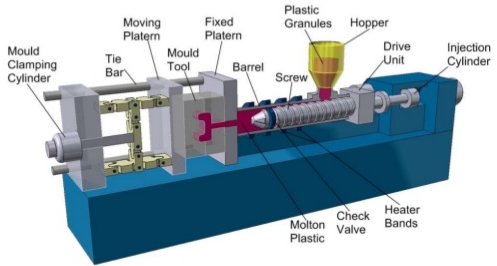6 Simple Techniques For Die Castings
Wiki Article
The 7-Minute Rule for Oem
Table of ContentsNot known Facts About Die CastingAll about Die CastingAn Unbiased View of ManufacturingManufacturing Industries - TruthsHow Manufacturing can Save You Time, Stress, and Money.An Unbiased View of Additive Manufacturing
The message on this web page is an example from our complete White Paper 'Shot Moulding for Purchasers' - * Example message * - for full overview click the download switch over! Intro This overview is intended for people who are wanting to source plastic mouldings. It gives a much needed insight right into all that is entailed with producing plastic components, from the mould tool needed to the moulding process itself.If you desire to check out even more, the guide covers types of mould tools, as well as special finishing procedures such as colours & plating. Words that are highlighted can be discovered in the glossary in the appendix ... Component I: Moulding: The Fundamentals The Advantages of Shot Moulding Plastic shot moulding is a very precise procedure that uses a number of advantages over various other plastic handling techniques.
Precision is perfect for really elaborate parts. You can hold this moulding in the hand of your hand as well as it has bosses, ribs, metal inserts, side cores and holes, made with a moving shut off function in the mould tool.
5 Simple Techniques For Plastic Manufacturing


from product feed & melting; material shot; cooling down time and also ejection to the re-closing of the mould tool prepared for the following cycle. Draft angles - The wall surfaces of a moulded component ought to be somewhat tapered in the instructions in which the part is ejected from the mould tool, to permit the part to be expelled quickly.
Ejector stroke - The pushing out of ejector pins to eject the moulded component from the mould tool. Ejector stroke speed, length and timing needs to be carefully managed to avoid damage to the ejectors as well as mould tool, but at the exact same time make the moulding cycle as brief as feasible.

4 Easy Facts About Oem Described
Ribs - When a plastic part has thin walls, ribs are included in the layout to make the slim wall surfaces more powerful Side cores - Side action which produces an attribute on a moulded component, at an opposing angle to the regular opening direction of the mould device. lean production. The side core requires to be able to pull back as the plastic part can not be ejected otherwise.
Wall surfaces - The sides of a moulded component The message on this page is an example from our complete White Paper 'Injection Moulding for Customers'.
Manufacturing procedure for creating components by infusing molten material right into a mould, or mold and mildew Streamlined diagram of the procedure Shot moulding (U.S. punctuation: injection molding) is a manufacturing procedure for producing parts by infusing molten product into a mould, or mold. more helpful hints Shot moulding can be carried out with a host of materials mainly consisting of metals (for which the process is called die-casting), glasses, elastomers, confections, as well as most commonly polycarbonate and also thermosetting polymers. Injection moulding is widely used for making a selection of components, from the tiniest parts to whole body panels of cars. Injection moulding utilizes a special-purpose equipment that has three parts: the shot system, the mould as well as the clamp.
An Unbiased View of Plastic Manufacturing
, with the volume utilized of the former being significantly higher.: 13 Thermoplastics are prevalent due to characteristics that make them highly ideal for injection moulding, such as ease of recycling, convenience for a large range of applications,: 89 and capacity to soften as well as flow on home heating.In numerous cavity moulds, each dental caries can be the same and create the very same parts or can be one-of-a-kind and also create numerous various Check This Out geometries during a solitary cycle. Moulds are generally made from device steels, however stainless steels as well as aluminium moulds are ideal for particular applications. Aluminium moulds are usually improper for high quantity manufacturing or parts with slim dimensional resistances, as they have inferior mechanical homes and also are much more vulnerable to put on, damage, as well as deformation during the shot as well as securing cycles; however, aluminium moulds are affordable in low-volume applications, as mould manufacture costs and also time are significantly lowered.
The screw delivers the raw material onward, mixes and homogenises the thermal and viscous distributions of the polymer, and reduces the needed home heating time by mechanically shearing the material as well as including a considerable amount of frictional heating to the polymer. The material feeds forward with a check shutoff as well as collects at the front of the screw into a quantity known as a shot. When sufficient product has actually gathered, the material is forced at high stress and speed into the part find here developing dental caries. The precise amount of shrinking is a function of the resin being used, and also can be reasonably foreseeable. To stop spikes in stress, the process generally makes use of a transfer placement representing a 9598% complete tooth cavity where the screw changes from a consistent rate to a constant stress control.
The smart Trick of Additive Manufacturing That Nobody is Talking About
The packaging stress is applied up until the entrance (tooth cavity entry) solidifies. Due to its small dimension, the gateway is typically the very first location to solidify through its entire thickness.: 16 Once the entrance solidifies, no even more product can enter the tooth cavity; appropriately, the screw reciprocates and also gets product for the following cycle while the product within the mould cools down so that it can be expelled and also be dimensionally stable.Report this wiki page